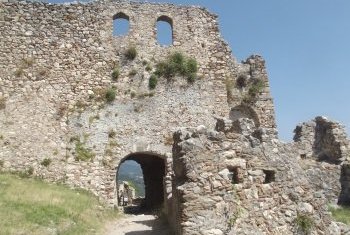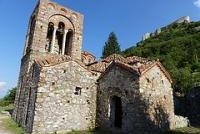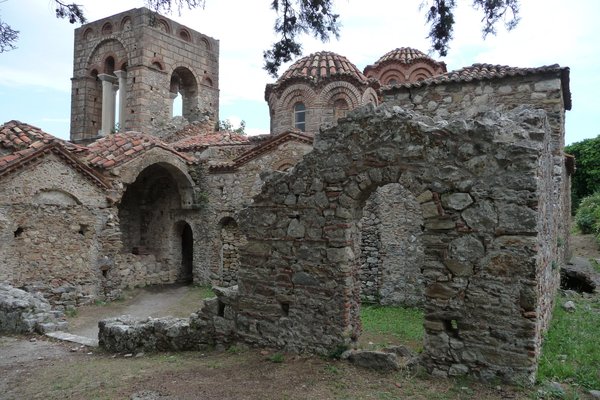Greece
Mystras
The Archaeological Site of Mystras is a relict townscape from the late medieval period.
Mystras was created as a castle, but the inhabitants of nearby Sparta fled to this safe place and developed it into a city. At the end of the 14th century, Mystras was the centre of Byzantine power in the Peloponnesus, became a bishopric and gained numerous monasteries and churches. The remains of palaces, mansions and urban residences also demonstrate its former importance and wealth.
Community Perspective: Walk its cobbled streets and “beautiful frescos and excellent Byzantine architecture will make your day”.
Site Info
Official Information
- Full Name
- Archaeological Site of Mystras (ID: 511)
- Country
- Greece
- Status
-
Inscribed 1989
Site history
History of Mystras
- 2007: Name change
- From "Mystras" to "Archaeological Site of Mystras"
- 1989: Deferred
- Bureau - conservation policy required
- 1989: Inscribed
- Inscribed
- Type
- Cultural
- Criteria
- ii
- iii
- iv
Links
- UNESCO
- whc.unesco.org
- Official
-
- odysseus.culture.gr — Hellenic Ministry of Culture and Tourism
All Links
UNESCO.org
- whc.unesco.org — whc.unesco.org/
Official Website
- odysseus.culture.gr — Hellenic Ministry of Culture and Tourism
News Article
- May 10, 2024 news.gtp.gr — Greece Restoring WHS of Mystras
Community Information
- Community Category
- Archaeological site: Byzantine
Travel Information
Peloponnese hotspot
Recent Connections
-
Palaeologan Renaissance
"Mystras constitutes a medieval city wh… -
Dubbed as another WHS
Florence of the East -
Name changes
archaeological site added to the name 2…
Connections of Mystras
- Trivia
-
-
Dubbed as another WHS
Florence of the East -
Built or owned by French
Guillaume II de Villehardouin
-
- History
-
-
Byzantine Empire and Civilization
Mystras constitutes a medieval city whose art, the fruit of the so-called Palaeologan Renaissance, influenced the development of Late Byzantine and Post-byzantine art. ... an exceptional example of a well-preserved fortified late-Byzantine city (OUV) -
Republic of Venice
Occupied from 1687 to 1715 -
Located in a Former Capital
Capital of Principality of Achaea (1249-1261) and Despotate of Morea (1380-1460)
-
- Architecture
-
-
Palaeologan Renaissance
"Mystras constitutes a medieval city whose art, the fruit of the so-called Palaeologan Renaissance, influenced the development of Late Byzantine and Post-byzantine art. The beauty of its churches, which during the Palaeologan Renaissance were covered with magnificent frescoes, Mystras is therefore a truly outstanding example of late Byzantine culture which influenced the rest of the Mediterranean world and beyond. " - OUV
-
- Human Activity
-
-
Silk Manufacture
The silk industry (silk worm culture) was the manufacturing and trading city's only resource. (AB ev)
-
- Timeline
-
-
Built in the 13th century
Mystras came into existence in 1248-49 (AB)
-
- WHS Hotspots
-
-
Peloponnese hotspot
140km
-
- WHS Names
-
-
Name changes
archaeological site added to the name 2007
-
News
- news.gtp.gr 05/10/2024
- Greece Restoring WHS of Mystras
Recent Visitors
Visitors of Mystras
- Afshin Iranpour
- Alberto Rodriguez Gutierrez
- Alexander Barabanov
- Alexander Lehmann
- A. Mehmet Haksever
- Ammon Watkins
- AmyAbroad
- Ana
- Andrew_Kerr
- Anna Wludarska
- Argo
- Artur Anuszewski
- Aspasia
- Astraftis
- Atila Ege
- AustralLights
- bergecn
- Bin
- Bropyk
- CeeMon
- Cezar Grozavu
- Christer Sundberg
- christof
- Christoph
- Christravelblog
- ClaraHH
- Cluckily
- Clyde
- Corinne Vail
- Csaba Nováczky
- Cyberczar
- Daniela Hohmann
- Daniel Gabi
- David Berlanda
- debatecoach
- del
- Dimitar Krastev
- Dimitrios Polychronopoulos
- DouglasR
- Echwel
- Eirini
- Elaine McArdle
- Elia Vettorato
- Els Slots
- emvcaest
- Evgenii
- Fan Yibo
- Farinelli
- Feldhase
- Femke Roos
- Francky D'Hoop
- Frederik Dawson
- Geo.Mav
- Gernot
- Giannis75
- Grzegorz Andruszkiewicz
- Hadrianus
- Harry Mitsidis
- henrik_hannfors
- henryjiao18
- Hubert
- Iain Jackson
- Ivan
- Ivan Rucek
- Jarek Pokrzywnicki
- Jens
- Jesse S 2010
- Joel on the Road
- Jonas Kremer
- Jonas Martinsson
- jonathanfr
- Joyce van Soest
- Kbecq
- Kelly Rogers
- kiank37
- KngAlaric
- Knut
- Krijn
- Kurt Lauer
- LaVale
- Lisu Marian
- Luboang
- Lucio
- Ludvan
- Luis Filipe Gaspar
- Maciej Gil
- Mahuhe
- marc Rouserez
- Martina Rúčková
- Marty
- Mateusz
- Matthewsharris
- Max
- MaYumin
- MichaelH
- Michael Turtle
- Mikko
- Milan Jirasek
- Monica Tasciotti
- nan
- nico4gr
- Nihal Ege
- PabloNorte
- Patrik
- Paul Schofield
- PeterH
- Petteri
- Philipp Leu
- Philipp Peterer
- Pink Bunny
- Piotr Wasil
- Rafał Kałczuga
- Ralf Regele
- Randi Thomsen
- Reisedachs
- Riccardo Quaranta
- Rick Ohm
- Roger Ourset
- Roman Bruehwiler
- Roman Raab
- Rubbie
- Rudegirl
- Shandos Cleaver
- Slavi
- sncjob
- Solivagant
- Stanislaw Warwas
- Svein Elias
- Szucs Tamas
- Taotao Chen
- Tarquinio_Superbo
- Tatiana Nikulnikova
- Tevity
- Thomas Buechler
- Thomas van der Walt
- Tim Allen
- tony0001
- triath
- Tsunami
- usagi1974
- ValiaVeweth
- Vanessa Buechler
- Viaje al Patrimonio
- Yevhen Ivanovych
- Yongcheng Liu
- Zoë Sheng
Community Reviews
Show full reviews
Mystras is awesome, I mean you're walking around ancient Sparta, when it became a medieval city.
Everywhere you go, the ruins look like the cover of a Black Sabbath album, which is one of the most incredible things ever.
I've been twice, both times in the winter, once in 2002, and another time in 2017. There was hardly anyone else around, which also made it super cool. I don't know what it's like in the summer, but I always rent a car and drive around, and it seemed more remote on the Pelopenese Peninsula than most people would try to get to. I had a great time hiking around, but I'd also recommend exploring the general area, as people are friendly, the food is good, and there are great times to be had all around. Yasoo!
Keep reading 0 comments
Mystras is a fine example of a Frankish and then late Byzantine town. Frankish you may wonder? Yes, Frankish. As you probably know, the glorious 4th Crusade ventured off path. Instead of attacking the Arabs and defending/liberating the Holy Land, they went off to capture Constantinople. For a while Frankish kings governed the Latin Empire and Frankish dukes and barons set up all over Greece, one of them in Lakonia, the area around ancient Sparta. Around 1250, the Frankish prince built a strong castle for the province at Mystras and a town grew around it.
Eventually, the Byzantine recaptured their capital and Lakonia, but the Byzantine Empire never recuperated from the damage done by the 4th Crusade. The Byzantine Empire was on it's deathbed. In the final years of the Byzantine Empire Mystras was the capital of the Despotate of the Morea. In 1460, Mystras surrendered to the Ottomans. Mystras itself remained an important city in the Ottoman Empire. It was only during the Greek War of Independence that the historic city was turned into ruin. A true pity.
What you get nowadays is a late medieval city in ruins that you can explore. You get a good feeling for the town plan and from the castle ruin great views of the area. Some of the monasteries remain and can be visited. If this hadn't been destroyed, it would be a truly great site.
Getting There
Main transport hub near Mystras is Sparti (Sparta). KTEL …
Keep reading 0 comments
The Byzantine city of Mystras occupies a whole hillside of the Taigetos Mountains. At the summit is the defensive castle, accessed by a steep, rugged track from the Upper Entrance to the site. From the castle there are extensive view over the plains of Sparti.
After visiting the castle I descended past the Upper Entrance, and continued following zig-zag paths to visit the various buildings of the Upper Town. The Palace was closed for restoration, but the nearby churches of St Sophia and St Nicholas with their colourful frescoes were open to visitors.
Descending to the Lower Town I passed the Pantanassa and the church of St Theodore before reaching the Metropolis, a monastery complex including the church of St Dimitrios. Here there are many more frescoes to be seen.
Keep reading 0 comments
I visited this WHS in June 2014. The mountain scenery alone is wonderful. However, walking uphill through the main gate, listening to the cattle bells echoeing in the valley, enjoying the wonderful breeze as you go from one quaint church to the next is definitely an experience nobody should miss when in the Peloponnese. My favourite churches with the best frescoes were the Agia Sofia and the Byzantine Metropolis Church. The view from the fortress/castle above is very worthwhile even though the Palace is under restoration at the moment.
Keep reading 0 comments
From Olympia I took the bus over the Peloponnesian Mountains. Even though I'm a Scandinavian and quite familiar with mountains, I must say it was a stunning experience to drive along the slopes and suddenly find yourself in a small mountain town where the local market forced my bus to a sudden stop. Or the horror experience of meeting a fully loaded lorry on a narrow mountain road with a 300 meter sloap just half a meter outside your window.
Having survived this close-to-a-heart-attach-experience I reached the relatively uninteresting town of Sparta. Some remains from an amphitheatre is about it on the archaeological menu. Instead the major sight is about 5 km west of the town, on a mountainside - the Byzantine town of Mystras - founded by the French crusaders and then developed into a major centre of culture and trade in the 13th and 14th century. I recommend you strongly to take a taxi as far up as you can, then climb the remaining 150 meters to the crusader castle and then take a slow walk down the remains of ancient Mystras. Small monasteries, churches and houses flanks the way down to the entrance, some 200 meters downhill. Beautiful frescos and excellent Byzantine architecture will make your day before you return to one of Sparta's better establishments for a nice Greek dinner.
Keep reading 0 comments
As of 2004 the Greek inscribed list of 16 mainly “classical” sites also contains 7 “non classical”, mainly Byzantine. Mystras is one of these, but unusual, in that it is now an uninhabited and largely ruined city. In the 14th and 15th centuries it had strong cultural credentials (Michelin talks of “The Florence of the Orient”!). These included philosophy as well as art and architecture. It surrendered to the Turks in 1460 but was not finally abandoned until it was pillaged during the Greek War of Independence around 1825
Today, its most obvious claim to fame rests on the (more than 12??) Byzantine “churches”, including a cathedral and several monasteries. Many have been restored and contain fine murals. These are of course “worth a visit” even for a non “Byzantium specialist” but it was the general atmosphere of calm and rural solitude which I remember. The large site provides plenty of opportunity to wonder the cobbled streets and courtyards at leisure soaking up the scent of wild flowers and looking out over the vistas of Greek countryside. Also, as I remember it, even finding “wild” tortoises (at least they were when we picked them up)! Avoid the heat of the day as it is built on the side of a mountain (photo) and there is a lot of climbing.
Keep reading 0 comments
Mystras is the best thing I saw (so far) in Greece. The city from the Middle Ages is plastered against a mountain near Sparta. It's December, but it looks like fall: brown trees, fresh but chilly air, some dark clouds. The entrance gate to Mystras welcomes you in true medieval style: I knew at once I was going to like it here.
What remains of the city are its churches, a monastery, some walls and roads. The steep, cobbled streets are mostly genuine and give the feeling of actually walking there in the 14th century. The roads were narrow then, so narrow the edges of buildings were removed to leave more space for passers-by. Of course, there were shops then, markets and handicraft businesses. It would be great to be able to time travel on this spot.
The focus points are the Byzantine churches of Mystras. They were restored, both inside and outside. Frescoes, with a lot of dark blue colours, have come to the surface. The red round or octagonal roofs stand out between the now brown and green trees that surround this site. You can only walk around this scenery openmouthed.
Keep reading 0 comments
